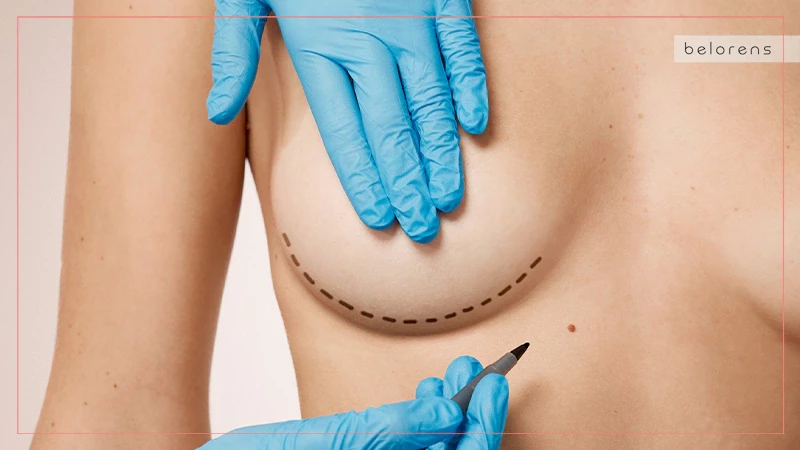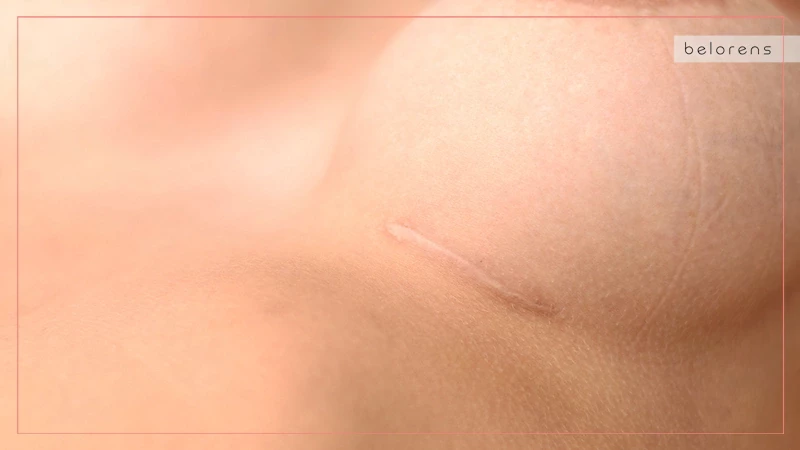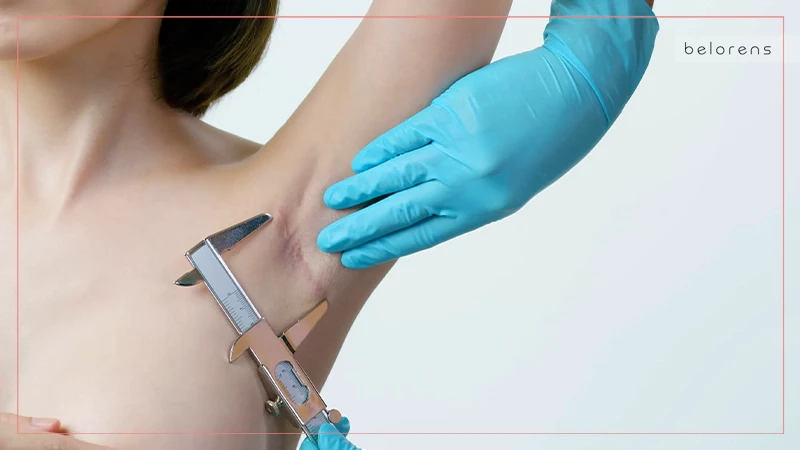Published on 29 Feb 2024
4 Types of Breast Implant Surgery Incisions: Which Technique is Right for Me?
- ByMedical Content Team
- Medically Reviewed byDr. Sabine Kulhanek
Fact checked

Breast augmentation is a deeply personal decision, often accompanied by a myriad of questions and concerns. One of the most crucial aspects to consider is the type of incision used during the procedure. This often-overlooked detail can significantly impact your surgery results and recovery time. So, whether you're contemplating breast augmentation surgery or simply fascinated by the world of cosmetic procedures, this blog post aims to shed light on the various types of breast implant incisions, helping you make an informed decision for your unique journey toward self-enhancement
There are several types of incisions that can be used for breast augmentation surgery, depending on the specific needs and preferences of the patient, as well as the surgeon's expertise. These types of incisions include inframammary incision, periareolar incision, transaxillary incision, and transumbilical incision (TUBA). Let’s see what’s each of these techniques like and what are their advantages and disadvantages.
Inframammary Incision

The inframammary incision is the most commonly used technique in breast augmentation surgery. It involves making an incision along the fold beneath the breast, known as the inframammary crease or fold.
During this procedure, the surgeon creates a discreet incision within this natural crease to gain access to the breast tissue. This allows for precise placement of the breast implant and provides excellent visibility during surgery.
One of the significant advantages of using an inframammary incision is that it offers direct access to the surgical site. This enables surgeons to have better control over implant positioning, resulting in more accurate placement and potentially enhanced aesthetic outcomes.
Additionally, this type of incision allows for easier revision or further procedures if needed in the future. The scar from an inframammary incision tends to be well-concealed within or just above the fold beneath your breasts, minimizing its visibility when wearing swimsuits or low-cut tops.

It's important to note that while there will be a scar present after surgery, it typically fades over time and becomes less noticeable with proper care and healing.
Pros:
- Provides excellent visibility and direct access to the breast tissue and chest wall.
- Allows for precise pocket creation and implant placement.
- Accommodates various types of breast implants.
- Can be used for both subglandular and submuscular implant placement.
- Scar is typically well-concealed within the natural fold of the breast.
- Lower risk of capsular contracture compared to some other incision techniques.
- Provides good access for future revision surgeries or implant removal.
Cons:
- Leaves a scar in the inframammary fold, though it is usually well-concealed.
- In rare cases, there may be an increased risk of damage to sensory nerves in the nipple area.
- Requires careful postoperative care to ensure proper healing.
- May not be suitable for individuals with certain anatomical considerations or preferences.
Periareolar Incision

The periareolar incision, also known as the areolar incision, is another technique used in breast augmentation surgery. It involves making an incision along the lower edge of the areola, which is the pigmented area surrounding the nipple.
During this procedure, the surgeon carefully creates an incision within this natural border to access the breast tissue and create a pocket for implant placement. The advantage of this approach is that it allows for direct visibility and precise control over implant positioning.
One notable benefit of the periareolar incision is its ability to provide excellent camouflage. The natural color transition between the darker areola skin and lighter breast skin helps conceal any resulting scars. This makes it particularly appealing for individuals who desire minimal visible scarring after their surgery.
It's important to note that while many patients opt for this type of incision due to its cosmetic advantages, there may be some potential drawbacks. For instance, there might be a slightly increased risk of affecting nipple sensation or breastfeeding capabilities compared to other types of incisions.
Pros:
- Scar Placement: The incision is made along the border of the areola, which can help camouflage the scar, as the color transition between the areola and the breast skin can help conceal it.
- Direct Access: The incision allows direct access to the breast tissue and chest wall for precise pocket creation and implant placement.
- Versatility: The periareolar incision can accommodate different types of breast implants, including saline, silicone gel, and structured implants.
- Simultaneous Procedures: If the patient requires a breast lift (mastopexy) in addition to augmentation, the periareolar incision can be used to perform both procedures simultaneously.
Cons:
- Scar Visibility: While the scar is usually well-concealed within the areolar border, it may be more visible compared to other incision techniques, especially in individuals with smaller areolas or lighter skin.
- Potential for Sensitivity Changes: There is a slight risk of temporary or permanent changes in nipple sensation due to the proximity of the incision to the nipple and nerve endings.
- Increased Risk of Infection: The periareolar incision carries a slightly higher risk of implant contamination and subsequent infection compared to some other incision techniques.
- Possible Impact on Breastfeeding: There is a small chance that the periareolar incision can disrupt the milk ducts, potentially affecting breastfeeding in the future. However, this risk is generally low.
Transaxillary Incision

The transaxillary incision is a technique used in breast augmentation surgery where the incision is made within the natural crease of the armpit region, known as the transaxillary area.
During this procedure, a small incision is made in one or both armpits to create a tunnel that leads to the desired implant placement site behind the breast tissue. The surgeon uses specialized tools and techniques to carefully navigate through this access point.
One key advantage of using a transaxillary incision is that it allows for implants to be inserted without any visible scarring on or near the breasts themselves. This can be particularly appealing for individuals who prefer minimal scarring on their breast area.
It's important to note that while this approach offers excellent scar concealment, it may have some limitations compared to other types of incisions. For example, certain implant types and placements may not be suitable for a transaxillary incision due to restricted access.
Pros:
- Scar Placement: The incision is made within the natural crease of the armpit, which helps keep the scar hidden and minimizes its visibility on the breast itself.
- No Visible Scar on the Breast: Since the incision is made in the armpit area, there is no direct scarring on the breast tissue, making it an appealing choice for individuals concerned about visible scars on their breasts.
- Reduced Risk of Nipple Sensation Changes: The transaxillary incision technique carries a lower risk of affecting nipple sensation compared to incision techniques made directly on the breast tissue.
- No Interference with Breastfeeding: The transaxillary incision does not disrupt the breast tissue or milk ducts, reducing the potential impact on breastfeeding.
Cons:
- Limited Visibility: The armpit area may offer limited visibility compared to incisions made directly on the breast tissue. This can make it slightly more challenging for the surgeon to create the desired pocket and position the implant accurately.
- Potential for Additional Scarring: While the incision is made in the armpit, there is still the possibility of scarring in that area.
- Increased Surgical Complexity: The transaxillary approach can be technically more challenging for the surgeon due to the need to create a tunnel and navigate through the armpit area to reach the breast pocket.
- Implant Size Limitations: The transaxillary incision may have size limitations for certain types of implants, particularly larger silicone gel implants or those requiring a textured surface.
- Revision and Explantation Challenges: If any future revision surgeries or implant removal is needed, accessing the breast area through the armpit may be more complex than other incision techniques.
Also Read: Breast Implants Shapes and Profiles: All You Need to Know
Transumbilical Incision
The transumbilical incision, also known as TUBA (Trans-Umbilical Breast Augmentation), is the least common technique used in breast implant surgery. It involves making an incision within the belly button (navel) to insert and position the breast implants.
During this procedure, a small incision is made at the base of the belly button. A tunnel or path is then created under the skin and muscle tissue from the navel up to the breasts. Through this access point, deflated saline implants are inserted and filled with sterile saline solution once they are properly positioned within each breast pocket.
One significant advantage of using a transumbilical incision is that it avoids any visible scarring on or near the breasts themselves. The resulting scar remains hidden within the natural folds of the belly button, offering excellent cosmetic camouflage.
However, it's worth noting that not all types of breast implants can be placed using this approach. Currently, only saline-filled implants can be utilized through a transumbilical incision due to their ability to be filled after insertion into place.
Pros:
- Scar Placement: The primary advantage of the transumbilical incision is that it leaves no visible scar on the breasts themselves. The incision is hidden within the belly button, making it an appealing choice for individuals concerned about visible breast scars.
- No Direct Breast Tissue Manipulation: With the transumbilical approach, there is no direct manipulation or scarring of the breast tissue. This may be preferable for individuals who want to avoid potential interference with breast sensitivity or breastfeeding.
- Potential for Quicker Recovery: Some patients may experience a faster recovery with the transumbilical incision due to the absence of incisions on the breast tissue itself. This can result in less postoperative discomfort and a shorter healing period.
Cons:
- Limited Control and Visibility: The transumbilical incision technique offers limited visibility and control compared to other incision techniques. The surgeon must navigate a tunnel from the navel to the breast, which can make it more challenging to achieve precise pocket creation and implant placement.
- Limited Implant Options: The transumbilical approach is typically limited to the use of saline implants. Silicone gel or structured implants, which are commonly preferred by many patients, cannot be inserted through this incision.
- Revision and Explantation Limitations: If any future revision surgeries or implant removal is required, accessing the breast area through the belly button can be more complex and may require additional incisions.
- Skill and Experience Requirements: The transumbilical incision technique requires specialized training and expertise. It is a technically demanding procedure that not all plastic surgeons are experienced in performing.
How to Choose the Right Breast Implant Incision for My Surgery?

Choosing the right incision technique for breast augmentation is a decision best made in consultation with an experienced plastic surgeon. Here are some factors to consider when determining which incision technique may be suitable for you:
- Personal Preferences: Consider your personal preferences regarding scarring and visibility. Different incisions have varying degrees of scarring and visibility, so it's important to choose an option that aligns with your aesthetic goals.
- Surgeon's Recommendation: Trust the expertise of your plastic surgeon. They will assess your individual anatomy, discuss the advantages and disadvantages of each technique, and guide you toward the most appropriate choice based on their experience.
- Implant Type and Size: The type (saline or silicone) and size of implants can influence which incision options are available to you. Some techniques may be better suited for certain implant types or sizes, so it's essential to consider this aspect as well.
- Body Anatomy: Your unique body anatomy plays a role in determining which incision approach is feasible and likely to yield optimal results. Factors such as breast shape, nipple position, existing scars, tissue quality, and skin elasticity should be carefully evaluated by your surgeon.
- Potential Future Procedures: If you anticipate undergoing additional procedures in the future (such as revision surgery), discuss this with your surgeon as it may impact their recommendation for an appropriate incision site.
Ultimately, open communication with your plastic surgeon is crucial throughout the decision-making process. They possess valuable knowledge about various techniques' outcomes and can help weigh the pros and cons based on your specific circumstances.
By considering these factors alongside professional guidance from a qualified plastic surgeon who understands both surgical techniques and individual patient needs, you can make an informed decision about selecting the right incision technique for breast augmentation surgery.




